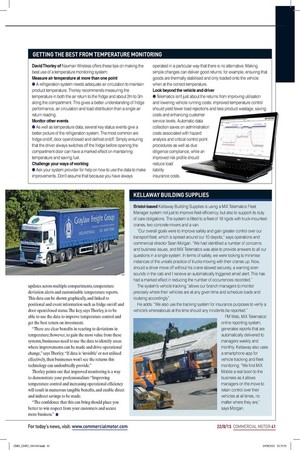GETTING THE BEST FROM TEMPERATURE MONITORING
Page 33

If you've noticed an error in this article please click here to report it so we can fix it.
David Thorley of Navman Wireless offers these tips on making the best use of a temperature monitoring system: Measure air temperature at more than one point
• A refrigeration system needs adequate air circulation to maintain product temperature. Thorley recommends measuring the temperature in both the air return to the fridge and about 2m to 3m along the compartment. This gives a better understanding of fridge performance, air circulation and load distribution than a single air return reading. Monitor other events
• As well as temperature data, several key status events give a better picture of the refrigeration system. The most common are fridge on/off, door open/closed and defrost on/off. Simply ensuring that the driver always switches off the fridge before opening the compartment door can have a marked effect on maintaining temperature and saving fuel. Challenge your ways of working • Ask your system provider for help on how to use the data to make improvements. Don't assume that because you have always
operated in a particular way that there is no alternative. Making simple changes can deliver good returns: for example, ensuring that goods are thermally stabilised and only loaded onto the vehicle when at the correct temperature. Look beyond the vehicle and driver • Telematics isn't just about the returns from improving utilisation and lowering vehicle running costs: improved temperature control should yield fewer load rejections and less product wastage, saving costs and enhancing customer • Telematics isn't just about the returns from improving utilisation and lowering vehicle running costs: improved temperature control should yield fewer load rejections and less product wastage, saving costs and enhancing customer
service levels. Automatic data collection saves on administration costs associated with hazard analysis and critical control point procedures as well as due diligence compliance, while an improved risk profile should reduce load liability insurance costs.
service levels. Automatic data collection saves on administration costs associated with hazard analysis and critical control point procedures as well as due diligence compliance, while an improved risk profile should reduce load liability insurance costs.









































